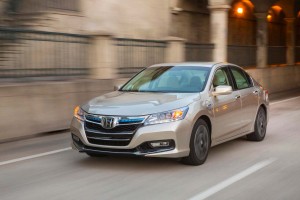Honda Motor Co. saw a nearly 63% surge in earnings for the October – December quarter, but the maker also issued a warning that earnings could take a tumble in the months ahead because of problems in China, now the world’s largest automotive market.
The Tokyo-based maker earned 77.4 billion yen, or $850 billion during its fiscal third quarter. That was, however, well off the 104.95 billion yen forecast of 11 analysts surveyed by the Nikkei Quick index.
Quarterly sales rose about 25%, to 2.4 trillion yen, or $26 billion. That increase reflected the maker’s recovery from the production shortages caused the prior year by Japan’s massive earthquake and tsunami. Demand was particularly strong in the North American market. But it also fell short in China as a result of that country’s ongoing dispute with Japan over the ownership of a chain of small, uninhabited islands in the East China Sea.
That dispute, as well as a general slowdown in the Chinese car market, led Honda to scale back its forecast for the full fiscal year, which ends on March 31. It now anticipates net profits of 370 billion yen, a 75% increase from the prior year – but a 1.3% reduction in the previous full-year forecast.
And that number had already been reduced by 20% due to such factors as the strong yen, which has reduced demand for products assembled in Japan. Like its home market competitors, Honda has been struggling to shift operations out of Japan to minimize the impact of lopsided exchange rates.
The yen has dipped slightly in recent weeks, but at less than 90 to the dollar it is still well short of the 100 yen target Honda and other automakers have suggested is necessary to help make Japanese production competitive again.
Like most makers, Honda is facing a mixed situation in markets around the world. It is struggling in Europe where sales last year fell to their lowest levels since 1995 – and which are expected to slide even further in 2013.
The North American market has been a bright spot, leading company officials to suggest they will be putting even more emphasis on their lucrative U.S. operations going forward.
China is the maker’s big challenge. Honda was one of the first Japanese makers to enter the market but like rivals Toyota and Nissan it has lagged the major players, such as General Motors and Ford, in part, due to long-standing animosity towards Japan, a holdover from the brutal occupation of China during World War II.
That lingering issue flared up last autumn when the Japanese government acquired what it calls the Senkoku Islands – which China also claims and calls the Daioyu. Rioting erupted around the country, a Toyota dealership burned and many Japanese vehicles damaged or destroyed. Demand for Japanese products has improved since then but still lags previous sales levels.


Rumors that I am hearing are that the Chinese car market is going flat and that all the major players are very concerned as their growth in China was covering for the economic issues in U.S. and Euro markets. With Europe on the verge of falling back into a recession for the third time – assuming you believe they ever actually got out of the one that has existed for 5+ years, the drop in the Chinese market could really throw the world economies in to a tizzy.
China is an interesting puzzle — even for the government folks regulating it. It’s a key part of the Chinese economic engine and a potentially huge export growth opportunity. But it’s also complicating life, especially in big cities now clogged with traffic and choked with pollution, so you may see more registration restrictions, etc. I think China will be a much less certain growth opportunity, at least in the near to mid-term, than some had anticipated until recently. Long-term, though, there’s a lot of country left to put on wheels.
Paul A. Eisenstein
Publisher, TheDetroitBureau.com